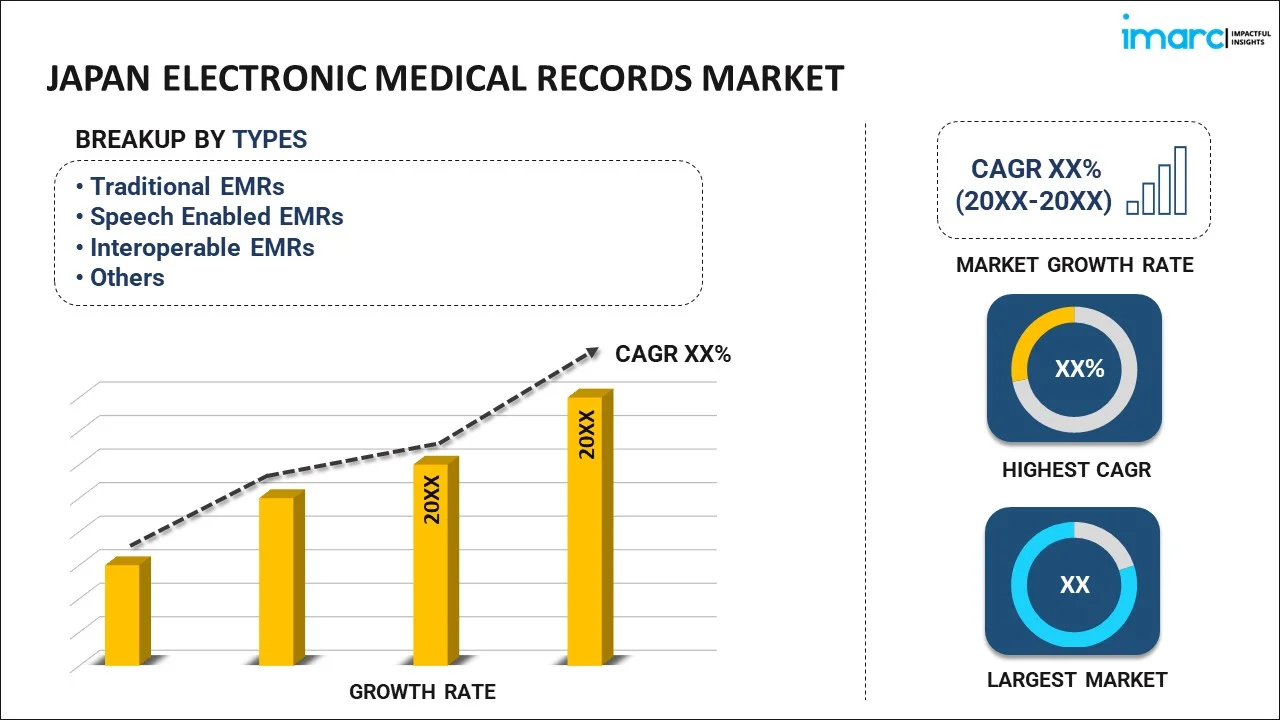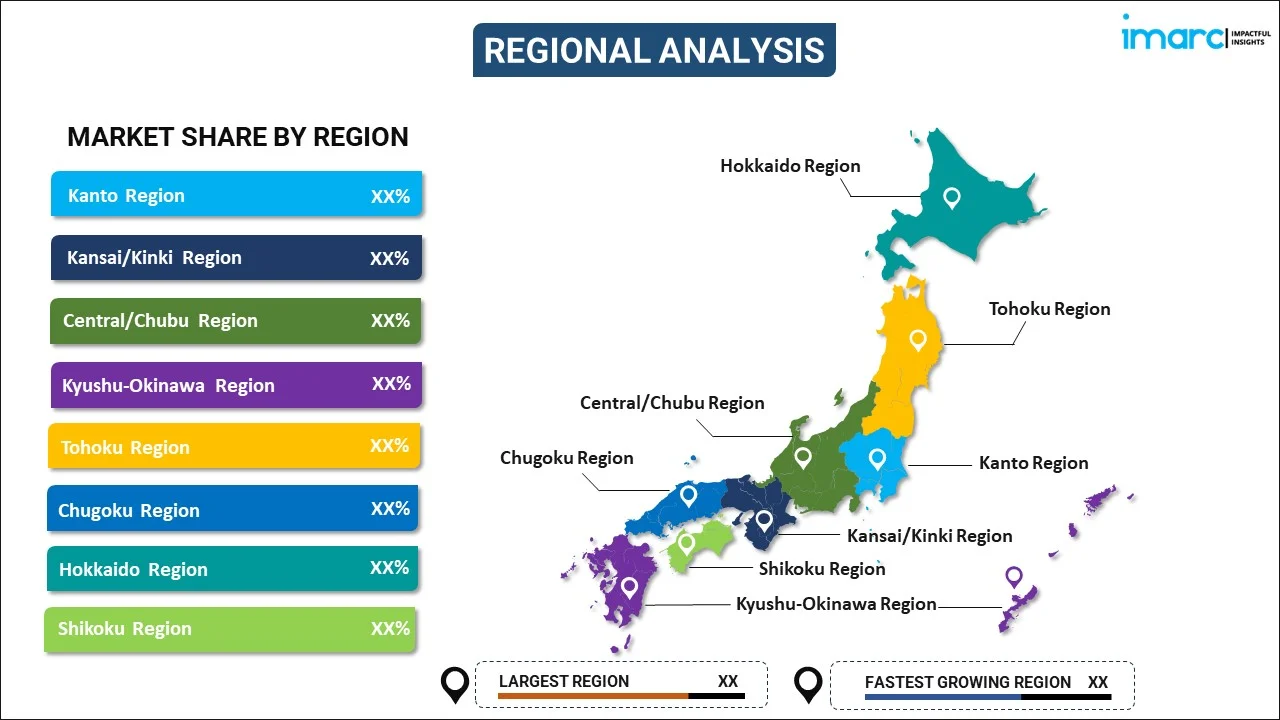
Japan Electronic Medical Records Market Report by Type (Traditional EMRs, Speech Enabled EMRs, Interoperable EMRs, and Others), Component (Hardware, Software, Services), Functionality (Basic Systems, Fully Functional Systems), Deployment Type (Cloud-based, On-premises), Application (Specialty Based, General Applications), End User (Hospitals and Clinics, Specialty Centers, and Others), and Region 2025-2033
Market Overview:
Japan electronic medical records market size reached USD 917.6 Million in 2024. Looking forward, IMARC Group expects the market to reach USD 1,722.5 Million by 2033, exhibiting a growth rate (CAGR) of 6.5% during 2025-2033. The increasing need for providing quality care to the patients and enhanced protection from data disruption caused by any accidents or mishaps is primarily driving the market growth.
|
Report Attribute
|
Key Statistics
|
|---|---|
|
Base Year
|
2024 |
|
Forecast Years
|
2025-2033 |
|
Historical Years
|
2019-2024
|
| Market Size in 2024 | USD 917.6 Million |
| Market Forecast in 2033 | USD 1,722.5 Million |
| Market Growth Rate (2025-2033) | 6.5% |
Electronic medical records (EMRs) are digital documents containing a patient's health-related information. This encompasses details such as patient demographics, medical background, prescribed medications, known allergies, radiology findings, immunization status, results of laboratory tests, vital signs, and billing particulars. EMRs can be implemented using cloud computing or on-site software. Cloud-based solutions facilitate centralized data storage and online access from various geographic locations, while on-premises solutions are employed to meet local computing needs. These organized records play a pivotal role in monitoring and overseeing patients, identifying trends, and enhancing the quality of healthcare provision. They also have the potential to improve communication and efficiency among healthcare providers and patients, ultimately leading to better health outcomes and increased patient safety.
Japan Electronic Medical Records Market Trends:
The electronic medical records (EMR) market in Japan is experiencing substantial growth and transformation, reflecting the country's commitment to modernizing its healthcare infrastructure. Japan, known for its advanced technology adoption, is increasingly recognizing the benefits of digital health records, and EMRs are at the forefront of this healthcare evolution. One key driver of the EMR market in Japan is the government's push for the widespread adoption of digital health records. Initiatives such as the "Japan Revitalization Strategy" and efforts to establish a nationwide health information exchange are driving investment and innovation in the EMR sector. Furthermore, the COVID-19 pandemic has underscored the importance of digital health solutions, accelerating the adoption of EMRs in Japan as healthcare providers seek efficient ways to manage patient data, telemedicine, and remote patient monitoring. The EMR market's growth in Japan is not only transforming healthcare delivery but also opening doors for innovative startups and tech companies. With a focus on interoperability and data security, the Japanese EMR market is poised for further expansion in the coming years, thereby contributing to improved patient care and the overall efficiency of the country's healthcare system.
Japan Electronic Medical Records Market Segmentation:
IMARC Group provides an analysis of the key trends in each segment of the market, along with forecasts at the country level for 2025-2033. Our report has categorized the market based on type, component, functionality, deployment type, application, and end user.
Type Insights:

- Traditional EMRs
- Speech Enabled EMRs
- Interoperable EMRs
- Others
The report has provided a detailed breakup and analysis of the market based on the type. This includes traditional EMRs, speech enabled EMRs, interoperable EMRs, and others.
Component Insights:
- Hardware
- Software
- Services
A detailed breakup and analysis of the market based on the component have also been provided in the report. This includes hardware, software, and services.
Functionality Insights:
- Basic Systems
- Fully Functional Systems
The report has provided a detailed breakup and analysis of the market based on the functionality. This includes basic systems and fully functional systems.
Deployment Type Insights:
- Cloud-based
- On-premises
A detailed breakup and analysis of the market based on the deployment type have also been provided in the report. This includes cloud-based and on-premises.
Application Insights:
- Specialty Based
- Cardiology
- Neurology
- Radiology
- Oncology
- Others
- General Applications
The report has provided a detailed breakup and analysis of the market based on the application. This includes specialty based (cardiology, neurology, radiology, oncology, and others) and general applications.
End User Insights:
- Hospitals and Clinics
- Specialty Centers
- Others
A detailed breakup and analysis of the market based on the end user have also been provided in the report. This includes hospitals and clinics, specialty centers, and others.
Regional Insights:

- Kanto Region
- Kansai/Kinki Region
- Central/ Chubu Region
- Kyushu-Okinawa Region
- Tohoku Region
- Chugoku Region
- Hokkaido Region
- Shikoku Region
The report has also provided a comprehensive analysis of all the major regional markets, which include Kanto Region, Kansai/Kinki Region, Central/ Chubu Region, Kyushu-Okinawa Region, Tohoku Region, Chugoku Region, Hokkaido Region, and Shikoku Region.
Competitive Landscape:
The market research report has also provided a comprehensive analysis of the competitive landscape. Competitive analysis such as market structure, key player positioning, top winning strategies, competitive dashboard, and company evaluation quadrant has been covered in the report. Also, detailed profiles of all major companies have been provided.
Japan Electronic Medical Records Market Report Coverage:
| Report Features | Details |
|---|---|
| Base Year of the Analysis | 2024 |
| Historical Period | 2019-2024 |
| Forecast Period | 2025-2033 |
| Units | Million USD |
| Scope of the Report | Exploration of Historical and Forecast Trends, Industry Catalysts and Challenges, Segment-Wise Historical and Predictive Market Assessment:
|
| Types Covered | Traditional EMRs, Speech Enabled EMRs, Interoperable EMRs, Others |
| Components Covered | Hardware, Software, Services |
| Functionalities Covered | Basic Systems, Fully Functional Systems |
| Deployment Types Covered | Cloud-based, On-premises |
| Applications Covered |
|
| End Users Covered | Hospitals and Clinics, Specialty Centers, Others |
| Regions Covered | Kanto Region, Kansai/Kinki Region, Central/ Chubu Region, Kyushu-Okinawa Region, Tohoku Region, Chugoku Region, Hokkaido Region, Shikoku Region |
| Customization Scope | 10% Free Customization |
| Post-Sale Analyst Support | 10-12 Weeks |
| Delivery Format | PDF and Excel through Email (We can also provide the editable version of the report in PPT/Word format on special request) |
Key Questions Answered in This Report:
- How has the Japan electronic medical records market performed so far and how will it perform in the coming years?
- What has been the impact of COVID-19 on the Japan electronic medical records market?
- What is the breakup of the Japan electronic medical records market on the basis of type?
- What is the breakup of the Japan electronic medical records market on the basis of component?
- What is the breakup of the Japan electronic medical records market on the basis of functionality?
- What is the breakup of the Japan electronic medical records market on the basis of deployment type?
- What is the breakup of the Japan electronic medical records market on the basis of application?
- What is the breakup of the Japan electronic medical records market on the basis of end user?
- What are the various stages in the value chain of the Japan electronic medical records market?
- What are the key driving factors and challenges in the Japan electronic medical records?
- What is the structure of the Japan electronic medical records market and who are the key players?
- What is the degree of competition in the Japan electronic medical records market?
Key Benefits for Stakeholders:
- IMARC’s industry report offers a comprehensive quantitative analysis of various market segments, historical and current market trends, market forecasts, and dynamics of the Japan electronic medical records market from 2019-2033.
- The research report provides the latest information on the market drivers, challenges, and opportunities in the Japan electronic medical records market.
- Porter's five forces analysis assist stakeholders in assessing the impact of new entrants, competitive rivalry, supplier power, buyer power, and the threat of substitution. It helps stakeholders to analyze the level of competition within the Japan electronic medical records industry and its attractiveness.
- Competitive landscape allows stakeholders to understand their competitive environment and provides an insight into the current positions of key players in the market.
Need more help?
- Speak to our experienced analysts for insights on the current market scenarios.
- Include additional segments and countries to customize the report as per your requirement.
- Gain an unparalleled competitive advantage in your domain by understanding how to utilize the report and positively impacting your operations and revenue.
- For further assistance, please connect with our analysts.
 Inquire Before Buying
Inquire Before Buying
 Speak to an Analyst
Speak to an Analyst
 Request Brochure
Request Brochure
 Request Customization
Request Customization




.webp)




.webp)












